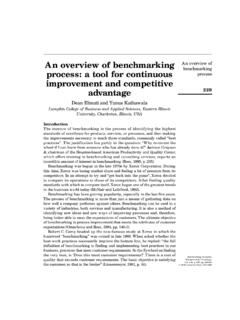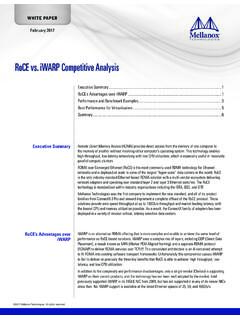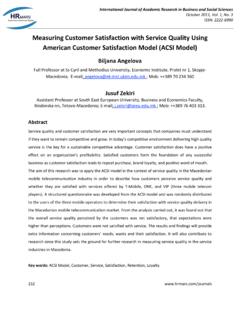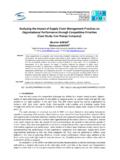Transcription of MEASURING PROGRESS TOWARDS SUSTAINABILITY …
1 1999 Greening of Industry Network Conference Best Practice Proceedings MEASURING PROGRESS TOWARDS SUSTAINABILITY . PRINCIPLES, PROCESS, AND BEST PRACTICES. Joseph Fiksel Jeff McDaniel Catherine Mendenhall Battelle Memorial Institute Life Cycle Management Group 505 King Avenue Columbus, Ohio 43201-2693. (614) 424-5730. 1999 Greening of Industry Network Conference Best Practice Proceedings ABSTRACT. A number of leading companies in the , Europe and Japan have made a commitment to become sustainable enterprises, and have launched proactive programs to improve the environmental and social performance of their products, processes, services, and facilities. However, one of the key challenges faced by these companies is how to track their PROGRESS TOWARDS SUSTAINABILITY and communicate it to both employees and other important stakeholders. This paper is intended to assist business decision-makers who wish to initiate continuous measurement and improvement of their triple bottom line, , the economic, environmental, and societal performance of their products, facilities, and enterprise.
2 First, a set of guiding principles is presented, suggesting that performance measurement should: 1) focus on both resource and value indicators, 2) explicitly represent the triple bottom line, 3) consider the full product life cycle, and 4) combine both leading and lagging indicators. Next, a comprehensive performance measurement process is described, including specific steps for planning, implementation, and review, based upon established practices within the business community. Finally, examples are given of five well-known companies that are recognized leaders in the field of SUSTAINABILITY measurement. The intent of this paper is to provide both a conceptual understanding of the state of the art, and a survey of best practices across several industries, thus creating a pragmatic foundation for establishing a customized SUSTAINABILITY measurement process within any company.
3 The paper is based upon Battelle's experience in developing and implementing performance measurement processes for a variety of industrial clients, including several leaders in the SUSTAINABILITY movement. In particular, the performance measurement process is based on the results of a multi-year program sponsored by the Electric Power Research Institute (EPRI). 1. 1999 Greening of Industry Network Conference Best Practice Proceedings INTRODUCTION. As the new millennium dawns, many leading companies in the , Europe and Japan are responding to the challenges of global population growth and environmental pressures by adopting a commitment to SUSTAINABILITY (Hart, 1996). Business leaders speak of sustainable development, sustainable growth, sustainable products, sustainable processes, and sustainable technologies. Many have launched proactive programs that include life cycle accounting, design for eco-efficiency, community outreach, clean technology development, and a variety of other initiatives.
4 In 1999, a group of companies including DuPont and General Motors collaborated in supporting a high-visibility National Town Meeting on SUSTAINABILITY . Their motivations are not purely altruistic recent research has demonstrated that pursuit of SUSTAINABILITY can not only result in environmental improvements and societal benefits, but can also increase economic value for the firm (Kiernan and Martin, 1998; Dixon, 1999). Yet few, if any, companies can respond definitively to the question, Which of our products, processes, services, and facilities are sustainable? Answering this question requires the ability to measure SUSTAINABILITY in a quantitative, or at least qualitative fashion. However, MEASURING SUSTAINABILITY differs from MEASURING other dimensions of business performance in several important respects. First, this practice is relatively new, so that there is a lack of commonly accepted or mandated measurement standards.
5 Second, SUSTAINABILITY is complex and multi-faceted, covering a broad spectrum of topics from habitat conservation, to energy consumption, to stakeholder satisfaction and financial results. Finally, measurement of SUSTAINABILITY extends beyond the boundaries of a single company and typically addresses the performance of both upstream suppliers and downstream customers in the value chain. While many firms are beginning to address this challenge, so far the main focus has been on the choice of appropriate performance indicators. For practitioners of performance measurement, there are many additional issues that need to be addressed , including the timing, data requirements, accountability assignments, communication, and pragmatic utilization of these indicators. We argue that SUSTAINABILITY performance measurement (SPM) must be approached as a systematic business process in order to be integrated effectively into company strategic planning and day-to-day operations.
6 This paper sets forth some fundamental principles for SPM, and describes a three-phase process for planning, implementing, and reviewing an SPM process. The focus is on the initial planning phase, which begins with articulation a SUSTAINABILITY policy and concludes with establishment of specific performance targets. The paper illustrates the application of the SPM principles and process by drawing upon industry best practices. Some important lessons can be learned from the companies that have already begun their journey TOWARDS SUSTAINABILITY , and are already MEASURING and reporting on their performance. A review of publicly available data shows that The Body Shop, BP Amoco, Collins & Aikman Floorcovering, Monsanto, and Volvo are applying these principles and following most of the SPM process steps. Analysis of their policies, objectives, performance indicators, and targets provides a number of insights about how the above-mentioned challenges can be addressed.
7 It is our hope that the approach and best practices presented here will help other companies to develop and improve their SPM practices, enabling a more rapid and widespread transition TOWARDS sustainable products and processes. We believe that the pressures of population growth, economic development, and resource scarcity will eventually compel all companies to address SUSTAINABILITY issues. Moreover, we argue that achievement of worldwide sustainable development will require the emergence of companies that routinely seek competitive advantage through simultaneous measurement and improvement of environmental, economic and social performance. 2. 1999 Greening of Industry Network Conference Best Practice Proceedings SUSTAINABILITY MEASUREMENT PRINCIPLES. Four fundamental principles can help companies address the challenges associated with MEASURING and reporting SUSTAINABILITY .
8 These are: 1. Address the dual perspectives of resource consumption and value creation. 2. Include economic, environmental, and societal aspects. 3. Systematically consider each stage in the product life cycle. 4. Develop both leading and lagging indicators. RESOURCE AND VALUE. The first principle of SUSTAINABILITY measurement is that evaluations should address the dual perspectives of resource consumption and value creation. A sustainable organization should strive to minimize resource consumption while maximizing value creation. Here, resources are defined broadly to be natural or anthropogenic stocks that are required for the creation, use and disposition of a product or service. Examples of resources include materials, energy, labor, and land. Value is defined as a condition, attributable to a company's activities, which benefits one or more of the organization's stakeholders (Fiksel et al, 1998).
9 Examples of value creation include increased profitability, reduced pollution, improved nutrition, and liberation of time. Figure 1 lists general categories of performance associated with resource consumption and value creation these provide a foundation for any company to select appropriate performance indicators. Resource Value Energy Functional performance Material Information content Water Customer satisfaction Land Environmental quality Waste Economic value added Cost Business competency Human capital Human health Investment capital Social welfare Figure 1. Resource Consumption versus Value Creation 3. 1999 Greening of Industry Network Conference Best Practice Proceedings TRIPLE BOTTOM LINE. The second principle of SUSTAINABILITY measurement is that evaluations should include economic, environmental, and societal aspects. Effective SUSTAINABILITY measurement should consider the complete triple bottom line of economic, environmental, and societal performance (Bennett and James, 1999).
10 These aspects need to be integrated and balanced in order to obtain a comprehensive understanding of product or service SUSTAINABILITY from the perspective of different stakeholders. For example, an automobile consumes economic resources in terms of operation and maintenance costs, environmental resources in terms of fossil fuel, and societal resources in terms of personal time spent driving. It also creates economic and social value, although it may detract from environmental quality. Today, most performance measurement frameworks focus exclusively on economic or environmental performance, and very few address societal concerns (James, 1997). However, based on the recent resurgence of attention to social responsibility, we anticipate an increased focus over the next decade on MEASURING the societal impacts of products and services. LIFE CYCLE CONSIDERATION. The third principle of SUSTAINABILITY measurement is that evaluations should systematically consider each stage in the product life cycle.







